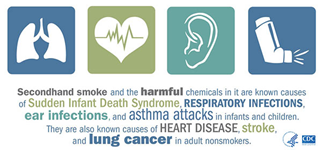Tobacco - Secondhand Smoke

Even if you have never smoked, secondhand smoke can still cause heart disease, lung cancer, and stroke. Even brief exposure to secondhand smoke can be harmful to your heart and blood vessels.4
-In 2019, almost 7 million U.S. middle and high school students (about 25%) reported breathing secondhand smoke in their homes, and just over 6 million (about 23%) reported breathing secondhand smoke in vehicles.

Children 4
Because their bodies are still growing, infants and young children are especially vulnerable to health risks from secondhand smoke.
-Babies who breathe secondhand smoke are more likely to die unexpectedly from sudden infant death syndrome (SIDS), also called crib death, than babies who are not exposed to smoke from burning tobacco products.
-Babies exposed to secondhand smoke in the womb or after birth are born and grow up with weaker lungs than babies that are not exposed to secondhand smoke.
-Babies and children who breathe secondhand smoke are sick more often with bronchitis, pneumonia, and ear infections than those that are not exposed to secondhand smoke.
-For children with asthma, breathing secondhand smoke can trigger an asthma attack.
Homes are the main places where babies, children, and teens are exposed to secondhand smoke.
-Smoking in another room like a bathroom or bedroom can still spread secondhand smoke through the air in your home. In an apartment building, secondhand smoke can go in between apartments.
-Smoking outside in a hall or stairwell does not protect children inside. Smoke goes under doors, windows, and through cracks.
-Opening a window or using a fan does not protect children from secondhand smoke.
-Air purifiers and air fresheners do not remove secondhand smoke.
-Smoke from one cigarette can stay in a room for hours. Don’t smoke at home, even when children aren’t there.
-Separating people who smoke from those who don’t smoke, cleaning the air and ventilating buildings does not fully protect children or adults from secondhand smoke.
-To protect the children inside, houses and apartment buildings must be smokefree.

